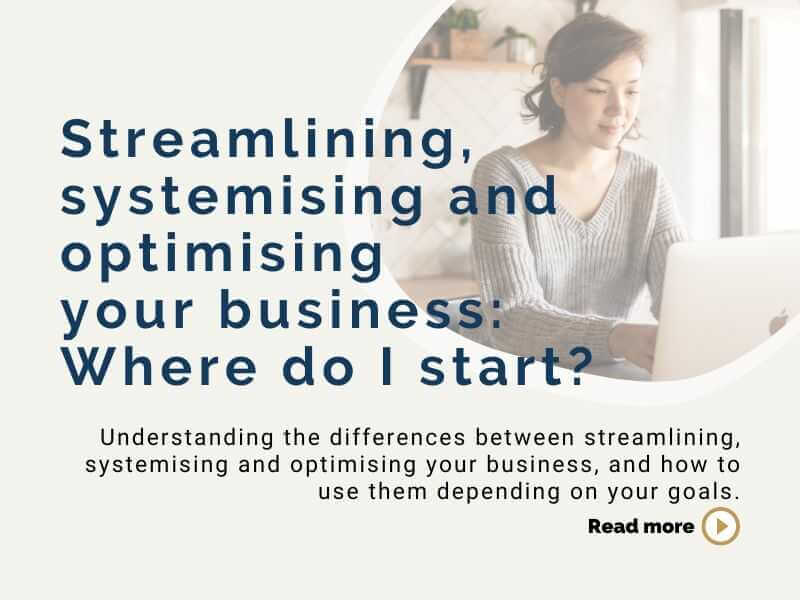Streamlining, systemising and optimising, oh my! This week on the blog we are following the yellow brick road from streamlining down to systemising and over to optimising your business.
One of the most common questions businesswomen have when it comes to these three business efficiency measures is: Where do I start?
That’s a good question and a great place to start. So let me share the difference between streamlining, systemising and optimising your business, and how to use them depending on your goals.
What is the difference between streamlining, systematising and optimising your business?
Before you can start streamlining, systemising and optimising, you will need to know the difference between the three.
I’ve been talking a lot about them this month and have written a few blogs about it. You can read my previous blogs here for more depth and information.
In a nutshell:
- Streamlining – Streamlining is used to improve, simplify and eliminate waste on existing processes and workflows. This activity will have a cost and time impact, while also improving the efficiency and productivity of your operations.
- Systematising – Systematising is the complete set of SOPs (standard operating procedures) for a specific department or business function. It’s a knowledge transfer from knowledge of the person who or automation that usually performs the task. It documents all the processes so the knowledge can be transferred and delegated to other team members, or even better, an automation.
- Optimising – Optimising your business is used to improve effectiveness after a task or process has been streamlined and systemised. This is where you can streamline the process even more to make it even more efficient. You would do this when you are maintaining your systems, processes and workflows.
Where do you start?
Now that you know the difference between streamlining, systematising and optimising, you can figure out where to start.
While the obvious choice may be to start with streamlining, you may already have your systems in place and just need to optimise them.
- STREAMLINE: If your goal is to improve efficiency and reduce your costs, you will want to start with streamlining first.
- SYSTEMATISE: If your goal is to organise your business and bring on team members, it’s time to start with systematising.
- OPTIMISE: If your goal is to improve the quality of your outcomes and accuracy of your work, then optimising your workflow is where you will start.
Real-life example: Streamline, systematise and optimise your business lead magnet
Do you have a lead magnet process? Have you streamlined, systematised and optimised it? If you have the process but it’s all over the place and you’re still doing it manually – streamline it.
If you’ve documented it but it’s still in your head and not automated, it’s time to systematise it so you can either automate it or delegate it.
And if it’s all automated but you’re not getting leads, that’s when you need to optimise it (improve it) to make it effective and attract more leads. Optimising might look like your content keywords, the imagery you use and targeting the right audience.
Systems, processes and workflows are important in business
If you need some help with streamlining, systematising and optimising your business, so you can work on your big vision, I’m ready to help weave some magic for you!
Book an initial chat to see if we are the right fit and how I can help you streamline your business processes.
Meanwhile, if you’re not at that stage yet, pop me in your back pocket and subscribe to my monthly newsletter where I share the latest news and workshops. You can sign up





